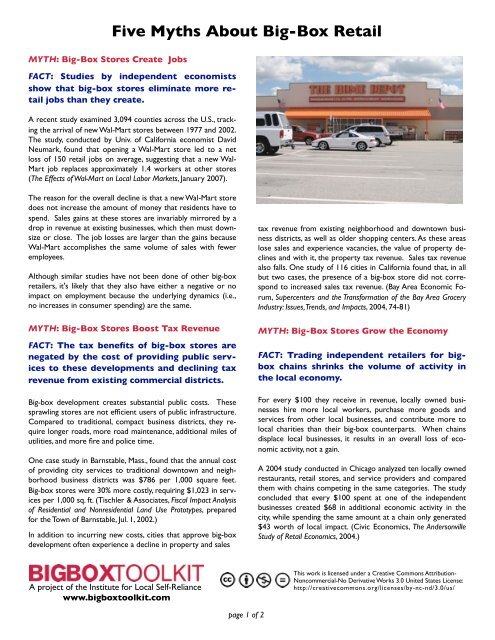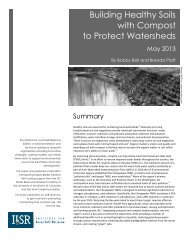Five Myths About Big-Box Retail - Institute for Local Self-Reliance
Five Myths About Big-Box Retail - Institute for Local Self-Reliance
Five Myths About Big-Box Retail - Institute for Local Self-Reliance
You also want an ePaper? Increase the reach of your titles
YUMPU automatically turns print PDFs into web optimized ePapers that Google loves.
MYTH: <strong>Big</strong>-<strong>Box</strong> Stores Create Jobs<br />
<strong>Five</strong> <strong>Myths</strong> <strong>About</strong> <strong>Big</strong>-<strong>Box</strong> <strong>Retail</strong><br />
FACT: Studies by independent economists<br />
show that big-box stores eliminate more retail<br />
jobs than they create.<br />
A recent study examined 3,094 counties across the U.S., tracking<br />
the arrival of new Wal-Mart stores between 1977 and 2002.<br />
The study, conducted by Univ. of Cali<strong>for</strong>nia economist David<br />
Neumark, found that opening a Wal-Mart store led to a net<br />
loss of 150 retail jobs on average, suggesting that a new Wal-<br />
Mart job replaces approximately 1.4 workers at other stores<br />
(The Effects of Wal-Mart on <strong>Local</strong> Labor Markets, January 2007).<br />
The reason <strong>for</strong> the overall decline is that a new Wal-Mart store<br />
does not increase the amount of money that residents have to<br />
spend. Sales gains at these stores are invariably mirrored by a<br />
drop in revenue at existing businesses, which then must downsize<br />
or close. The job losses are larger than the gains because<br />
Wal-Mart accomplishes the same volume of sales with fewer<br />
employees.<br />
Although similar studies have not been done of other big-box<br />
retailers, it's likely that they also have either a negative or no<br />
impact on employment because the underlying dynamics (i.e.,<br />
no increases in consumer spending) are the same.<br />
MYTH: <strong>Big</strong>-<strong>Box</strong> Stores Boost Tax Revenue<br />
FACT: The tax benefits of big-box stores are<br />
negated by the cost of providing public services<br />
to these developments and declining tax<br />
revenue from existing commercial districts.<br />
<strong>Big</strong>-box development creates substantial public costs. These<br />
sprawling stores are not efficient users of public infrastructure.<br />
Compared to traditional, compact business districts, they require<br />
longer roads, more road maintenance, additional miles of<br />
utilities, and more fire and police time.<br />
One case study in Barnstable, Mass., found that the annual cost<br />
of providing city services to traditional downtown and neighborhood<br />
business districts was $786 per 1,000 square feet.<br />
<strong>Big</strong>-box stores were 30% more costly, requiring $1,023 in services<br />
per 1,000 sq. ft. (Tischler & Associates, Fiscal Impact Analysis<br />
of Residential and Nonresidential Land Use Prototypes, prepared<br />
<strong>for</strong> the Town of Barnstable, Jul. 1, 2002.)<br />
In addition to incurring new costs, cities that approve big-box<br />
development often experience a decline in property and sales<br />
A project of the <strong>Institute</strong> <strong>for</strong> <strong>Local</strong> <strong>Self</strong>-<strong>Reliance</strong><br />
www.bigboxtoolkit.com<br />
page 1 of 2<br />
tax revenue from existing neighborhood and downtown business<br />
districts, as well as older shopping centers. As these areas<br />
lose sales and experience vacancies, the value of property declines<br />
and with it, the property tax revenue. Sales tax revenue<br />
also falls. One study of 116 cities in Cali<strong>for</strong>nia found that, in all<br />
but two cases, the presence of a big-box store did not correspond<br />
to increased sales tax revenue. (Bay Area Economic Forum,<br />
Supercenters and the Trans<strong>for</strong>mation of the Bay Area Grocery<br />
Industry: Issues, Trends, and Impacts, 2004, 74-81)<br />
MYTH: <strong>Big</strong>-<strong>Box</strong> Stores Grow the Economy<br />
FACT: Trading independent retailers <strong>for</strong> bigbox<br />
chains shrinks the volume of activity in<br />
the local economy.<br />
For every $100 they receive in revenue, locally owned businesses<br />
hire more local workers, purchase more goods and<br />
services from other local businesses, and contribute more to<br />
local charities than their big-box counterparts. When chains<br />
displace local businesses, it results in an overall loss of economic<br />
activity, not a gain.<br />
A 2004 study conducted in Chicago analyzed ten locally owned<br />
restaurants, retail stores, and service providers and compared<br />
them with chains competing in the same categories. The study<br />
concluded that every $100 spent at one of the independent<br />
businesses created $68 in additional economic activity in the<br />
city, while spending the same amount at a chain only generated<br />
$43 worth of local impact. (Civic Economics, The Andersonville<br />
Study of <strong>Retail</strong> Economics, 2004.)<br />
This work is licensed under a Creative Commons Attribution-<br />
Noncommercial-No Derivative Works 3.0 United States License:<br />
http://creativecommons.org/licenses/by-nc-nd/3.0/us/
One of the main reasons <strong>for</strong> the difference was that the local<br />
retailers bought more goods and services from other local<br />
businesses. They did their banking at a local bank. They hired<br />
local accountants, web designers, and other professionals. They<br />
turned to a local print shop <strong>for</strong> their printing, and they advertised<br />
in local publications. The chains had almost no need <strong>for</strong><br />
these local services and spent relatively little in the city.<br />
A consequence of this is that even modest shifts in the mix of<br />
local and non-local businesses in a community can have significant<br />
economic ramifications. A case study in Kent County,<br />
Michigan, estimates that the region would gain 1,600 new jobs,<br />
$140 million in new economic activity, and $53 million in additional<br />
payroll if residents shifted 10% of their spending from<br />
chains to local businesses. A shift in the opposite direction —<br />
more spending at chains — would cause equivalent economic<br />
losses. (Civic Economics, <strong>Local</strong> Works: Examining the Impact of<br />
<strong>Local</strong> Business on the Western Michigan Economy, 2008.)<br />
MYTH: <strong>Big</strong>-<strong>Box</strong> Stores Bring Competition and<br />
Consumer Choice<br />
FACT: <strong>Big</strong>-box stores often displace numerous<br />
small and mid-sized stores, leaving fewer<br />
shopping options and less competition.<br />
An average Wal-Mart or Target supercenter is nearly four<br />
football fields in size (190,000 square feet) and captures about<br />
$80 million a year in spending. To understand how large that<br />
is, consider that it would take 35,000 people making 25% of all<br />
of their retail purchases, from groceries to appliances, at that one<br />
Wal-Mart store. To take another example, the average<br />
120,000-square-foot Lowe's captures $35 million a year in<br />
sales. That's equal to the total hardware/building materials<br />
spending power of 37,000 people.<br />
Most communities, even fast-growing ones, cannot absorb a<br />
store of this scale without sizable revenue losses to existing<br />
businesses, including both locally owned stores and competing<br />
supermarkets and shopping centers. Part of the reason these<br />
companies build such large stores is that they leave little room<br />
in the market <strong>for</strong> other businesses. As competing stores close,<br />
residents are left with fewer choices. Many towns and neighborhoods<br />
now depend on a single big-box store <strong>for</strong> many<br />
types of goods, virtually eliminating competition.<br />
Once they attain a dominant share of the market, these retailers<br />
may raise prices. One study compared the cost of 54 gro-<br />
A project of the <strong>Institute</strong> <strong>for</strong> <strong>Local</strong> <strong>Self</strong>-<strong>Reliance</strong><br />
www.bigboxtoolkit.com<br />
page 2 of 2<br />
cery items at 11 Wal-Mart supercenters in Nebraska and found<br />
that the total varied by more than 13 percent. Some of the<br />
stores with the highest prices were in areas that lacked competing<br />
grocery stores. (Hometown Merchants Association,<br />
Impact of Supercenters on Nebraska Economy, April 2004.)<br />
A growing number of communities are deciding that a better<br />
way to ensure competition is to have numerous small and midsized<br />
stores, rather than one giant superstore. One way to<br />
achieve this is to place a cap on the size of stores (<strong>for</strong> more on<br />
this see our Store Size Cap Policy Kit at bigboxtoolkit.com).<br />
MYTH: <strong>Big</strong>-<strong>Box</strong> Stores are the Only Option<br />
FACT: More cities and towns are saying no to<br />
additional big-box development and finding<br />
better ways to grow by creating and expanding<br />
local businesses.<br />
Nearly 300 communities have rejected big-box proposals in<br />
the last few years, and many have adopted policies that restrict<br />
or prohibit this type of development altogether.<br />
Far from impeding growth, these policies often attract new<br />
small businesses investment as entrepreneurs seek out viable<br />
locations.<br />
Communities can spur more small business development by<br />
revitalizing their neighborhood and downtown commercial<br />
districts, launching programs to train and finance new entrepreneurs,<br />
and developing a strong Buy <strong>Local</strong> campaign to encourage<br />
more public support <strong>for</strong> locally owned businesses.<br />
(For more in<strong>for</strong>mation on these strategies, see the Building<br />
Alternatives to <strong>Big</strong> <strong>Box</strong>es section at bigboxtoolkit.com.)<br />
This work is licensed under a Creative Commons Attribution-<br />
Noncommercial-No Derivative Works 3.0 United States License:<br />
http://creativecommons.org/licenses/by-nc-nd/3.0/us/





